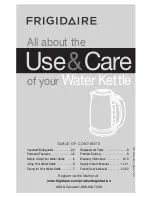
4.
GENERAL
Environment:
Insure gas and electrical supplies match rating plate.
Installation of the kettle must be accomplished by qualified
installation personnel working to all applicable local and
national codes.
This equipment is built to comply with applicable standards
for manufacturers. Included among those approval agencies
are: UL, NSF, ASME/N.Bd., CSA, ETL, and others. Many local
codes exist, and it is the responsibility of the owner/installer to
comply with these codes.
Observe all clearance requirements. Do not obstruct the flow
of combustion and ventilation air.
RECEIVING INSPECTION
Before unpacking visually inspect the unit for evidence of
damage during shipping.
If damage is noticed, do not unpack the unit, follow shipping
damage instructions.
SHIPPING DAMAGE INSTRUCTIONS
If shipping damage to the unit is discovered or suspected,
observe the following guidelines in preparing a shipping
damage claim.
1.
Write down a description of the damage or the reason for
suspecting damage as soon as it is discovered. This will
help in filling out the claim forms later.
2.
As soon as damage is discovered or suspected, notify
the carrier that delivered the shipment.
3.
Arrange for the carrier's representative to examine the
damage.
4.
Fill out all carrier claims forms and have the examining
carrier sign and date each form.
UNCRATING
Caution
:
Straps under tension and will
snap when cut.
Carton may contain staples
and skid contains nails.
Use proper safety equipment
and precautions.
Unit is heavy use adequate
help or lifting equipment as
needed.
1.
Carefully cut any straps
from container.
2.
Lift off carton.
3.
Inspect for hidden
damage.
If found refer to
“SHIPPING DAMAGE
INSTRUCTIONS”.
4.
Cut strap holding unit.
5.
Remove lag bolts from feet.
6.
Remove manual from
kettle pot. Write down the
model# and serial# of the
unit onto the front of this
manual.
7.
Lift kettle off skid and
move kettle to its
installation location.
8.
Discard packaging
material according to local and or state requirements.
VENTILATION
Gas fired kettles are only to be installed
under a ventilation hood in a room which
has provisions for adequate make up air.
Further information can be obtained by
referring to the U.S.A. National Fire
Protection Associations NFPA96 regulations. These standards
have also been adopted by the National Building Code in
Canada.
Operation of these units can produce significant levels of steam and
condensate, it is recommended they be installed under a ventilation
hood in a room which has provisions for adequate make up
air. Further information can be obtained by referring to the
U.S.A. National Fire Protection Associations NFPA96
regulations. These standards have also been adopted by the
National Building Code in Canada.
COMPRESSED AIR CONNECTION
Mixer Kettles with an air activated discharge valve require a
minimum of 90 PSI to operate correctly.
If the unit is also supplying air to a Metering Filling Station then a
pressure of 100 PSI at a minimum volume of 25 CFM is required.
The air supplied to the mixer should be clean and dry. No oil should
be added to the supply air. We recommend the compressed air
system be equipped with a drier, filter, and automatic water dump on
the air compressor receiver tank. If the distance between the tank
and the unit is less than 100 feet then a minimum line size of 3/4" is
required. A distance of 100 to 300 feet requires a minimum 1" line.
INSTALLATION
Model/
Serial#
Operating Criteria
Acceptable Range
Ambient Air Temperature 15-40 degrees Celsius
Relative Humidity
0-80%
Altitude
0-3000 meters
Voltage
208-480, 3ph
Location
Inside building, under
ventiltation hood
Model #
Unit
Unit with shipping box
MKGL-40-T
780 lbs.
850 lbs.
MKGL-60-T
855 lbs.
925 lbs.
MKGL-80-T
930 lbs.
1,000 lbs
.
APPROXIMATE WEIGHTS






































